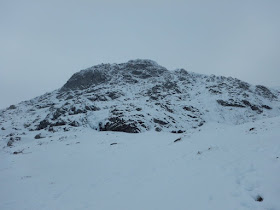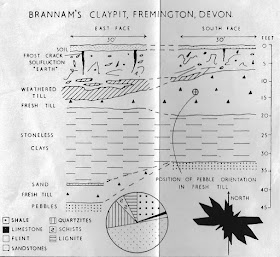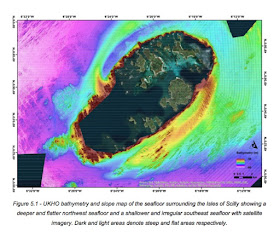On this map, Ed Lockhart places the eastern terminus (the dashed line) some distance to the west of the coasts of Devon and Cornwall, and somewhere in the vicinity of the Isles of Scilly. The acceptance of a "terminal moraine" on the north coast of the archipelago is difficult to accommodate in any scheme that might be devised!
Further to my previous post, let's give some more consideration to what happened in the Late Devensian to the eastern terminus of the Celtic Sea piedmont ice lobe.
Reference:
https://www.researchgate.net/publication/339106826_Glacial_sculpting_and_post-glacial_drowning_of_the_Celtic_Sea_2019_PhD_Thesis?channel=doi&linkId=5e3dae0892851c7f7f25f0c1&showFulltext=true
Glacial sculpting and post-glacial drowning of the Celtic Sea.
Thesis submitted in accordance with the requirements of Bangor University for the degree of Doctor of Philosophy
By Edward Alan Lockhart
School of Ocean Sciences Bangor University, Wales
August 2019(PDF)
-----------------------------
This rather complex image shows both satellite imagery (for the archipelago) and bathymetric and slope data. It seems to show NE-SW streamlining both to the NW and SE of the islands; these might be inherited features from an earlier glaciation.
This is what the author says:
Isles of Scilly & Cornwall
Ice advance northeast-southwest across the shelf was interpreted to have achieved a lateral limit along the northwest coastline of the Isles of Scilly (Scourse, 1991; Scourse et al., 1990), but the extent of ice towards the coastline of Cornwall is currently unknown. Subglacially smoothed bedrock with a consistent southwest orientation exists to the northwest of the Isles of Scilly and Land’s End (Figure 3.7 and Image G in Table 4.2), suggesting that ice flowed southwest past the western Isles of Scilly with ice originating in the northeast. While the orientation of the smoothed bedrock features may be inherited from the structure of the parent geology, their smooth appearance is indicative of erosion by ice (Krabbendam et al., 2016). When the pre-existing bedrock structure is coincidently orientated with ice flow direction, the elongation ratio of streamlined features may not represent a proxy for ice flow speed (Phillips et al., 2010), however the ice flow direction can still be inferred (Krabbendam et al., 2016). As these features appear to comprise sculpted bedrock, they may have been formed by an earlier glaciation and preserved. However, the recovery of Late Pleistocene sediments from the Isles of Scilly suggests that these features formed during the last glaciation as ice was grounded in this area. On the southeast side of the Isles of Scilly, bedrock outcrops also have a southwest orientation while appearing more prominent and irregular compared to subglacially smoothed bedrock to the northwest (Figure 5.1). Additionally, outcropping bedrock 10-20 km offshore of Cornwall has a similar character to bedrock exposed at the seafloor southeast of the Isles of Scilly, appearing sharp and irregular with no glacial signatures (Figure 5.2). This suggests that glacial sculpting of outcropping bedrock only occurred on the northwest side of the Isles of Scilly, coincident with the islands being interpreted as the lateral limit of the ISIS (Scourse, 1991; Scourse et al., 1990), as opposed to a terminal limit as suggested by John (2018). Therefore, these observations suggest that warm-based and grounded ice dominated the northwest side of the Isles of Scilly, flowing to the southwest, and did not reach the coastline of Cornwall.
Glacial sculpting of outcropping Devonian and Carboniferous rock adjacent to the Isles of Scilly and offshore of the coastline of Cornwall requires sediment-laden warm-based ice to abrade bedrock 4 km away from the islands yet did not result in them being overridden based on terrestrial observations. Such a configuration can be most simply accommodated by ice flow from the northeast to the southwest past the northwest coastline of the islands, abrading the bedrock further offshore (Figure 5.1) consistent with the southwest orientation of the rock drumlins (Plot I in Table 3.1). Therefore, ice on the eastern lateral periphery of the main ice stream trunk was in contact with the northwest coastline of the Isles of Scilly but did not advance beyond this. This configuration suggests that ice flowed parallel to the coastline of Cornwall from the Lundy Platform channels which must have been occupied during the LGM.
The water depth range of 70-90 m over which smoothed bedrock drumlins are found in this area (Table 3.1) suggests that sediment-laden warm-based ice dominated below the present-day -70 m isobath on the eastern inner-shelf. Therefore, an ice margin bordering the contemporary coastline of Cornwall seems unlikely, as there is no bathymetric expression of a glacial influence within 10-20 km offshore (Figure 5.2), nor any onshore evidence of glacial erosion and/or sedimentation. The Lundy Platform channels also occur below 70 m water depth (Table 3.1), similar to the shallowest occurrence of smoothed bedrock. Therefore, the eastern ice margin for this region previously suggested by Sejrup et al. (2005) appears to best fit these observations which delineate a lateral ice margin position at the present-day -70 m isobath (Figure 5.3).
-------------------------
This is all a bit convoluted, and involves a number of dodgy assumptions and connections which are not entirely logical -- but I sympathise! It is not an easy scenario to interpret.
1. At present, the apparent streamlining features to NW and SE of the islands might be Devensian features, or might be inherited features from a previous glaciation. I don't have a problem with the features being of Devensian age, since I think there is evidence of glacier ice "wrapping around the archipelago" and affecting the western and southern islands. The author of this thesis ignores my published evidence on this. I would not be at all surprised if evidence is found of glacier ice affecting the east coasts as well.

Red line: the maximum extent of Devensian glaciation in the Isles of Scilly, after Scourse and others. Black line: revised limit, taking into account all known fresh glacigenic deposits. It is quite possible that the ice pushed southwards on the eastern flank of the archipelago as well. It may even be helpful to envisage the archipelago as a series of nunatak summits projecting above the surface of an enveloping ice mass.
 Did the Isles of Scilly look something like this at the time of the LGM?
Did the Isles of Scilly look something like this at the time of the LGM?
2. The author of this thesis has not provided any evidence that contradicts the ice movement directions shown on the above map. If glacier ice reached the west coast of St Mary's, it must have been flowing eastwards, even if that was just for a short period.
3. If the streamlined features to the east of the islands are accepted as Devensian, then there must have been a substantial thickness of glacier ice off Land's End. So the author's suggested ice edge position off Cornwall must be at fault.
The suggested Devensian ice limit on the eastern flank of the piedmont ice lobe. The line seems to be positioned so as to "enclose" known features such as channels and submerged drumlin fields, but it ignores a good deal of other evidence. For example, in the box labelled (1) there are streamlines running NW-SE, ie directly towards the coast. Do they have no significance?
4. The author says, with respect to Cornwall, that there is "no onshore evidence of glacial erosion and/or sedimentation." That is incorrect. There are deposits on the coast at Trebetherick that have been interpreted by Francis Synge and others as Irish Sea till or "remanie deposits" derived from a till layer. Ed may not be convinced by the evidence, but he should at least have considered it. Much more convincing is the evidence of Irish Sea till (with the same characteristics as that of eastern Ireland and Pembrokeshire) at Middleborough House, Fremington, Croyde, and other localities near Barnstaple in Devon. The evidence enumerated by Nick Stephens and others may be disputed, but I have seen some of it, and am in no doubt that the till is real, and stratigraphically equivalent to that seen on the north and west coasts of Pembrokeshire. Again, Ed might not like the evidence, but he should have considered it.
5. The map shown above shows Lundy Island far to the east of the Devensian ice edge. As discussed on this blog, there is a jolly dispute going on regarding the glaciation of Lundy. But some researchers think that the island was affected by overriding Devensian ice, and their work should at least have been considered.
6. Finally, we come to the evidence from the west and south coasts of Pembrokeshire. In his maps, Ed shows (over and again) Devensian ice flowing from NNE to SSW:
Synthesis of ice flow directions and piedmont glacier extent, based on the accumulated evidence presented in the thesis.
This is not what happened. The evidence collected by me and many other researchers over the years is that the ice that affected the Pembrokeshire coast came in from the NW, flowing broadly towards the SE. Leaving aside for the moment the extent of Devensian ice cover in Pembrokeshire, ice from this direction affected the coasts of the St Davids Peninsula and the Dale Peninsula, the inner reaches of St Bride's Bay, and the mouth of Milford Haven. Ice travelling eastwards affected virtually the whole coastline as far east as Caldey Island and Saundersfoot Bay. So the ice of the Celtic Sea piedmont lobe pushed far into the Bristol Channel, and is highly likely to have affected, if not overtopped, Lundy Island. The author of this thesis should have shown his awareness of the accumulated evidence, and he should have placed his line of easternmost ice extent tight up against the coasts of Devon and Cornwall.
=======================
PS. Just to show how much disagreement there is among specialists, here is a map published by Prof David Evans -- supposedly based on work by Colm O'Cofaigh and others:
https://brian-mountainman.blogspot.com/2019/01/nice-map-not-much-evidence.html

This is supposed to represent the Devensian LGM iceflow scenario following research that shows that the whole of Southern Ireland was inundated by thick Devensian glacier ice and that there was no large ice-free enclave. The flow of the Irish Sea ice stream across NW Pembs is completely wrong, but as mentioned in my many posts on the Celtic Sea piedmont glacier, I have some sympathy with the portrayal of ice flow south-eastwards from the Midlands of Ireland......
Dave Evans and Ed Lockhart cannot both be right. I think it's fair to say that we can anticipate further arguments.......
Ref:
Late Pleistocene chronostratigraphy and ice sheet limits, southern Ireland
Colm Ó Cofaigh et al
Quaternary Science Reviews, Volume 44, 21 June 2012, Pages 160-179
The morpho-stratigraphic subdivision of the surficial glacial drifts of Ireland into ‘Older Drift’ and ‘Younger Drift’ is a long-standing convention in Irish Quaternary studies. Across southern Ireland a broad swath of terrain has traditionally been interpreted as Munsterian (penultimate glaciation) in age and large end moraine complexes bordering this zone of ‘Older Drift’ such as the ‘South Ireland End Moraine’ have long been regarded as marking the limit of the Late Midlandian (last glaciation) ice sheet. Sedimentary sequences exposed along the south coast of Ireland provide a window into the stratigraphy of the ‘Older Drift’ and have been studied for over a century. The present paper supports a fundamental revision of the traditional interpretation of ice sheet limits in southern Ireland and argues for an extensive last Irish Ice Sheet which covered much of the area of the Older Drift at the Last Glacial Maximum. The basis for this revision is threefold. Firstly, nineteen new optically stimulated luminescence (OSL) dates on the Courtmacsherry Raised Beach and overlying shallow marine sands demonstrate that on the south coast the beach and shallow marine sands formed during marine isotope stages 4–3. Secondly, AMS radiocarbon dates on reworked shells from the ‘Irish Sea Till’, demonstrate that this till and overlying ‘inland’ tills from central and SW Ireland were formed after ∼24 cal ka BP. Thirdly, new OSL dates of 24–21 ka BP from deglacial outwash overlying the Irish Sea Till. Collectively these data are consistent with a last glaciation age for the glacigenic sequence along the south coast of Ireland, thus supporting a fundamental revision of the age of the Older (Munsterian) Drifts of southern Ireland. Most of southern Ireland was glaciated during the LGM and the moraine belts which have traditionally been interpreted as marking the last glacial limit such as the South Ireland End Moraine are reinterpreted here as recessional features formed during ice sheet retreat.


































